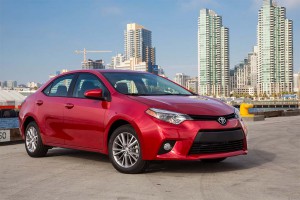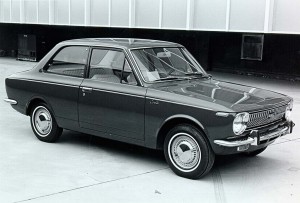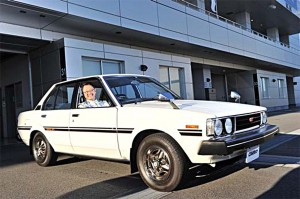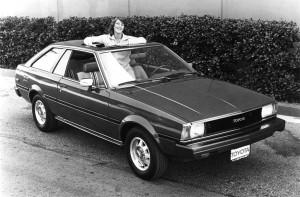It is not just one of the longest-running nameplates in automotive history, but also the industry’s all-time best-seller. And as the Toyota Corolla celebrates its 50th anniversary, it remains the top-selling car on the planet.
But now in its eleventh generation, the question is whether Corolla will be able to maintain that momentum much longer in the face of growing competition. Perhaps the biggest challenge it faces, on a global basis, is soaring demand for utility vehicles at the expensive of sedans and other passenger car models.
Corolla sales actually slipped 2.4% for the first nine months of this year. But the nameplate still held a substantial, 215,000 unit lead over its nearest competitor, the Volkswagen Golf, with little likelihood the compact Toyota will be toppled from its sales throne in the near-term.
The Corolla proved to be a critical breakthrough for Toyota Motor Corp. It struggled to build momentum as the Japanese economy began to rebound from the Second World War. The Publica gained little traction in the home market, and Toyota had even less success when it launched its first U.S. offering, the Toyopet, in 1957.
So, there were plenty of skeptics when the maker launched production of the Corolla on November 5, 1966. At the time, Toyota’s total production was barely 50,000 a month. The goal was to roll out 30,000 of the original, two-door Corolla models.
The compact model proved unexpectedly successful, but really didn’t reach its stride until 1973, in the wake of the first Mideast oil shock. As motorists all over the world – and especially in the U.S. – suddenly started downsizing, Toyota struggled to meet demand. By 1974, the Toyota Corolla captured the crown as the world’s best-selling automobile, a position it has held, with only rare exception, ever since.
In 1997, Corolla brushed by the Volkswagen Beetle to become the best-selling nameplate in automotive history. It set another milestone in July 2013, just as the eleventh-generation model was set for launch, Corolla sales topping the 40 million mark.
Few cars are built in more locations, various versions of the Toyota Corolla now rolling off assembly lines in Japan, Brazil, Canada, China, India and eight other countries – and sold in 150 different national markets.
The Corolla was the first car Toyota built at its original U.S. plant, the New United Motor Manufacturing Inc, or NUMMI, facility in Fremont, California. It was originally run as a joint venture with General Motors, but GM pulled out after its bankruptcy and Toyota shuttered the plant in March 2010. Corolla now rolls off a line in Mississippi.
(Toyota makes push into car-sharing. Click Here for more.)
For those familiar with Toyota, the name, Corolla, is part of an early pattern, playing off the maker’s Crown sedan model. “Corolla” is the Latin word for “small crown.”
Despite its wild popularity, the Corolla hasn’t always been a darling of automotive reviewers. The original car wasn’t necessarily designed to be best in any category. Instead, former World War II aircraft designer and Toyota lead engineer Tatsuo Hasegawa wanted a vehicle that would be an “80-plus points” car, one that got a more than passing grade in key attributes, especially quality and reliability – which went on to become Toyota hallmarks.
The original model was a bit more sporty than Japanese rivals of the time, with a 1.1-liter four-cylinder engine and a 4-speed manual transmission. The first Corolla was a hatchback, and it was significantly smaller than today’s iteration, barely even a subcompact by current standards. Over the years, however, it has grown larger and more lavishly equipped, with a variety of different body configurations. These days, however, the hatchback version is now known as the Auris.
(Toyota recalling 5.8 mil vehicles after latest Takata airbag death. Click Here for the latest.)
With the launch of the latest generation – 2012 in Japan, 2013 in the U.S. – Toyota set out to overcome one of the most frequent complaints about the Corolla: it’s traditionally conservative design. With Akio Toyoda, grandson of the company’s founder at the helm, the goal has been to put more “passion” into the corporate design language. The current Corolla was one of the first to be targeted.
The move certainly paid off, at least initially. Corolla has racked up another 4.3 million sales since the latest model was launched. For the first nine months of this year it remained the global sales leader, with customers around the world buying 945,812 of them, compared to 730,178 Volkswagen Golfs, the second nameplate on the list. In the U.S., Corolla sales jumped 2% in an otherwise down October market, Toyota itself suffering an overall 8.7% dip for the month.
But not everything is upbeat. Those global sales were actually down 2.4% for the first three quarters of this year. In the home market, meanwhile, Honda’s Fit toppled the Corolla in 2002, and the Toyota mainstay is, today, even outsold by two of the Japanese giant’s other models, the Aqua and Prius. Japanese motorists are today buying barely a quarter of the Corollas they did in 1973, when demand peaked at 400,000.
Worldwide, Corolla faces the challenge of surging sport and crossover-utility vehicle sales. Company officials in the U.S. have noted that if the current trend continues, their RAV4 ute could soon surpass both Corolla and the bigger Camry. And with the crossover trend expanding around the world, it remains to be seen if Corolla will be able to hold onto its little crown much longer.
(New Toyota C-HR crossover to make debut at LA Auto Show. Click Here to check it out.)




